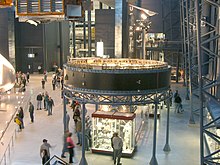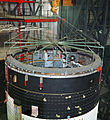
The George C. Marshall Space Flight Center (MSFC), located in Redstone Arsenal, Alabama, is the U.S. government's civilian rocketry and spacecraft propulsion research center. As the largest NASA center, MSFC's first mission was developing the Saturn launch vehicles for the Apollo program. Marshall has been the lead center for the Space Shuttle main propulsion and external tank; payloads and related crew training; International Space Station (ISS) design and assembly; computers, networks, and information management; and the Space Launch System. Located on the Redstone Arsenal near Huntsville, MSFC is named in honor of General of the Army George C. Marshall.
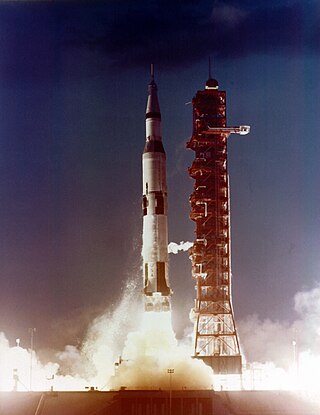
Apollo 4, also known as SA-501, was the uncrewed first test flight of the Saturn V launch vehicle, the rocket that eventually took astronauts to the Moon. The space vehicle was assembled in the Vehicle Assembly Building, and was the first to be launched from Kennedy Space Center (KSC) in Florida, ascending from Launch Complex 39, where facilities built specially for the Saturn V had been constructed.

Apollo 5, also known as AS-204, was the uncrewed first flight of the Apollo Lunar Module (LM) that would later carry astronauts to the surface of the Moon. The Saturn IB rocket bearing the LM lifted off from Cape Kennedy on January 22, 1968. The mission was successful, though due to programming problems an alternate mission to that originally planned was executed.

Apollo 6, also known as AS-502, was the third and final uncrewed flight in the United States' Apollo Program and the second test of the Saturn V launch vehicle. It qualified the Saturn V for use on crewed missions, and it was used beginning with Apollo 8 in December 1968.

AS-201, flown February 26, 1966, was the first uncrewed test flight of an entire production Block I Apollo command and service module and the Saturn IB launch vehicle. The spacecraft consisted of the second Block I command module and the first Block I service module. The suborbital flight was a partially successful demonstration of the service propulsion system and the reaction control systems of both modules, and successfully demonstrated the capability of the command module's heat shield to survive re-entry from low Earth orbit.
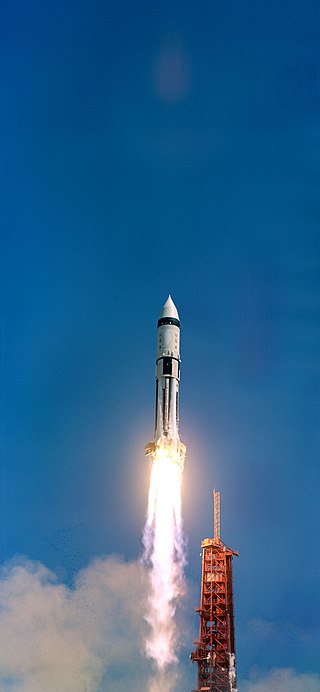
AS-203 was an uncrewed flight of the Saturn IB rocket on July 5, 1966. It carried no command and service module, as its purpose was to verify the design of the S-IVB rocket stage restart capability that would later be used in the Apollo program to boost astronauts from Earth orbit to a trajectory towards the Moon. It achieved its objectives, but the stage was inadvertently destroyed after four orbits.

AS-202 was the second uncrewed, suborbital test flight of a production Block I Apollo command and service module launched with the Saturn IB launch vehicle. It was launched on August 25, 1966, and was the first flight which included the spacecraft guidance, navigation control system and fuel cells. The success of this flight enabled the Apollo program to judge the Block I spacecraft and Saturn IB ready to carry men into orbit on the next mission, AS-204.

Saturn-Apollo 3 (SA-3) was the third flight of the Saturn I launch vehicle, the second flight of Project Highwater, and part of the American Apollo program. The rocket was launched on November 16, 1962, from Cape Canaveral, Florida.

AS-101 was the sixth flight of the Saturn I launch vehicle, which carried the first boilerplate Apollo spacecraft into low Earth orbit. The test took place on May 28, 1964, lasting for four orbits. The spacecraft and its upper stage completed a total of 54 orbits before reentering the atmosphere and crashing in the Pacific Ocean on June 1, 1964.

AS-102 was the seventh flight of the Saturn I launch vehicle, which carried the boilerplate Apollo spacecraft BP-15 into low Earth orbit. The test took place on September 18, 1964, lasting for five orbits. The spacecraft and its upper stage completed 59 orbits before reentering the atmosphere and crashing in the Indian Ocean on September 22, 1964.

The Apollo spacecraft was composed of three parts designed to accomplish the American Apollo program's goal of landing astronauts on the Moon by the end of the 1960s and returning them safely to Earth. The expendable (single-use) spacecraft consisted of a combined command and service module (CSM) and an Apollo Lunar Module (LM). Two additional components complemented the spacecraft stack for space vehicle assembly: a spacecraft–LM adapter (SLA) designed to shield the LM from the aerodynamic stress of launch and to connect the CSM to the Saturn launch vehicle and a launch escape system (LES) to carry the crew in the command module safely away from the launch vehicle in the event of a launch emergency.

The Saturn IB(also known as the uprated Saturn I) was an American launch vehicle commissioned by the National Aeronautics and Space Administration (NASA) for the Apollo program. It uprated the Saturn I by replacing the S-IV second stage, with the S-IVB. The S-IB first stage also increased the S-I baseline's thrust from 1,500,000 pounds-force (6,700,000 N) to 1,600,000 pounds-force (7,100,000 N) and propellant load by 3.1%. This increased the Saturn I's low Earth orbit payload capability from 20,000 pounds (9,100 kg) to 46,000 pounds (21,000 kg), enough for early flight tests of a half-fueled Apollo command and service module (CSM) or a fully fueled Apollo Lunar Module (LM), before the larger Saturn V needed for lunar flight was ready.
The Saturn I was a rocket designed as the United States' first medium lift launch vehicle for up to 20,000-pound (9,100 kg) low Earth orbit payloads. The rocket's first stage was built as a cluster of propellant tanks engineered from older rocket tank designs, leading critics to jokingly refer to it as "Cluster's Last Stand". Its development was taken over from the Advanced Research Projects Agency in 1958 by the newly formed civilian NASA. Its design proved sound and flexible. It was successful in initiating the development of liquid hydrogen-fueled rocket propulsion, launching the Pegasus satellites, and flight verification of the Apollo command and service module launch phase aerodynamics. Ten Saturn I rockets were flown before it was replaced by the heavy lift derivative Saturn IB, which used a larger, higher total impulse second stage and an improved guidance and control system. It also led the way to development of the super-heavy lift Saturn V which carried the first men to landings on the Moon in the Apollo program.

The J-2, commonly known as Rocketdyne J-2, was a liquid-fuel cryogenic rocket engine used on NASA's Saturn IB and Saturn V launch vehicles. Built in the United States by Rocketdyne, the J-2 burned cryogenic liquid hydrogen (LH2) and liquid oxygen (LOX) propellants, with each engine producing 1,033.1 kN (232,250 lbf) of thrust in vacuum. The engine's preliminary design dates back to recommendations of the 1959 Silverstein Committee. Rocketdyne won approval to develop the J-2 in June 1960 and the first flight, AS-201, occurred on 26 February 1966. The J-2 underwent several minor upgrades over its operational history to improve the engine's performance, with two major upgrade programs, the de Laval nozzle-type J-2S and aerospike-type J-2T, which were cancelled after the conclusion of the Apollo program.
Several planned missions of the Apollo crewed Moon landing program of the 1960s and 1970s were canceled, for reasons which included changes in technical direction, the Apollo 1 fire, hardware delays, and budget limitations. After the landing by Apollo 12, Apollo 20, which would have been the final crewed mission to the Moon, was canceled to allow Skylab to launch as a "dry workshop". The next two missions, Apollos 18 and 19, were later canceled after the Apollo 13 incident and further budget cuts. Two Skylab missions also ended up being canceled. Two complete Saturn V rockets remained unused and were put on display in the United States.

The Launch Vehicle Digital Computer (LVDC) was a computer that provided the autopilot for the Saturn V rocket from launch, through Earth orbit insertion, and the trans-lunar injection burn that would send the Apollo spacecraft to the Moon. Designed and manufactured by IBM's Electronics Systems Center in Owego, New York, it was one of the major components of the Instrument Unit, fitted to the S-IVB stage of the Saturn V and Saturn IB rockets. The LVDC also supported pre- and post-launch checkout of the Saturn hardware. It was used in conjunction with the Launch Vehicle Data Adaptor (LVDA) which performed signal conditioning from the sensor inputs to the computer from the launch vehicle.
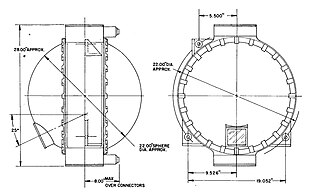
The ST-124-M3 inertial platform was a device for measuring acceleration and attitude of the Saturn V launch vehicle. It was carried by the Saturn V Instrument Unit, a 3-foot-high (0.91 m), 22-foot-diameter (6.7 m) section of the Saturn V that fit between the third stage (S-IVB) and the Apollo spacecraft. Its nomenclature means "stable table" (ST) for use in the Moon mission (M), and it has 3 gimbals.

The Saturn V dynamic test vehicle, designated SA-500D, is a prototype Saturn V rocket used by NASA to test the performance of the rocket when vibrated to simulate the shaking which subsequent rockets would experience during launch. It was the first full-scale Saturn V completed by the Marshall Space Flight Center (MSFC). Though SA-500D never flew, it was instrumental in the development of the Saturn V rocket which propelled the first men to the Moon as part of the Apollo program. Built under the direction of Dr. Wernher von Braun, it served as the test vehicle for all of the Saturn support facilities at MSFC.

The Saturn V is a retired American super heavy-lift launch vehicle developed by NASA under the Apollo program for human exploration of the Moon. The rocket was human-rated, had three stages, and was powered by liquid fuel. Flown from 1967 to 1973, it was used for nine crewed flights to the Moon, and to launch Skylab, the first American space station.

The ASC-15 was a digital computer developed by International Business Machines (IBM) for use on the Titan II intercontinental ballistic missile (ICBM). It was subsequently modified and used on the Titan III and Saturn I Block II launch vehicles.


